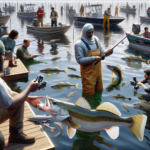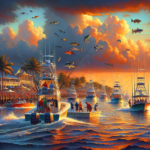Walleye Tournament on the Great Lakes

Introduction
Imagine the thrill of reeling in a walleye, its golden scales shimmering in the sunlight, as you compete against some of the best anglers in the world. This is the excitement that the Walleye Tournament on the Great Lakes brings to fishing enthusiasts every year. With over 20% of the world’s fresh water, the Great Lakes offer an unparalleled fishing experience, making them a prime location for walleye tournaments.
In this article, we will delve into the intricacies of the Walleye Tournament on the Great Lakes, covering everything from fishing techniques and species information to the best fishing spots and seasonal considerations. Whether you’re a seasoned angler or a novice looking to participate in your first tournament, this guide will provide you with all the information you need to succeed.
Understanding the significance of walleye tournaments is crucial for anyone interested in fishing. These events not only offer a competitive platform but also promote sustainable fishing practices and contribute to local economies. So, let’s dive in and explore what makes the Walleye Tournament on the Great Lakes a must-attend event for fishing enthusiasts.
Background/Context
Historical or Cultural Significance
The Great Lakes have a rich history of fishing that dates back thousands of years. Indigenous peoples relied on these waters for sustenance long before European settlers arrived. Walleye, in particular, has been a staple in the diets of many communities around the Great Lakes. Over time, walleye fishing evolved from a means of survival to a popular recreational activity, culminating in organized tournaments that attract anglers from all over the world.
Geographical Overview
The Great Lakes consist of five interconnected freshwater lakes: Superior, Michigan, Huron, Erie, and Ontario. These lakes span over 94,000 square miles and are bordered by eight U.S. states and the Canadian province of Ontario. The region’s climate varies from cold winters to warm summers, creating diverse fishing conditions throughout the year. The lakes’ ecosystems are home to a wide variety of fish species, making them ideal for walleye tournaments.
Key Points/Details
Fishing Techniques
Technique Overview
Walleye fishing techniques can vary, but some of the most effective methods include trolling, jigging, and casting. Trolling involves dragging lures or bait behind a moving boat, while jigging requires vertical movements of the bait to attract fish. Casting, on the other hand, involves throwing the bait or lure into the water and retrieving it to mimic the movement of prey.
When and Where to Use
Trolling is particularly effective in open waters and during the warmer months when walleye are more active. Jigging works well in deeper waters and during colder months when walleye tend to stay near the bottom. Casting is versatile and can be used in various conditions, but it is especially effective near structures like rocks and weed beds where walleye often hide.
Recommended Gear
- Rods: Medium to medium-heavy rods are ideal for walleye fishing.
- Reels: Spinning reels are commonly used due to their versatility.
- Lines: Braided lines with a fluorocarbon leader are recommended for their strength and sensitivity.
- Bait/Lures: Minnows, nightcrawlers, and artificial lures like crankbaits and jigs are effective for walleye.
Species Information
Species Overview
Walleye (Sander vitreus) are known for their olive and gold coloration and their distinctive, reflective eyes. They are primarily nocturnal and prefer cooler, deeper waters. Walleye are opportunistic feeders, preying on smaller fish, insects, and crustaceans. They are most active during dawn and dusk, making these times ideal for fishing.
Best Practices
To successfully catch walleye, it’s essential to understand their behavior and habitat. Focus on fishing during low-light conditions and target areas with structures like drop-offs, weed beds, and rocky bottoms. Using live bait like minnows or nightcrawlers can increase your chances of success. Additionally, varying your retrieval speed and technique can help trigger strikes from walleye.
Location Information
Top Fishing Spots
- Lake Erie: Known for its abundant walleye population, particularly around the Western Basin.
- Lake Ontario: Offers excellent walleye fishing near the Bay of Quinte.
- Lake Huron: The Saginaw Bay area is a hotspot for walleye.
- Lake Michigan: Green Bay is renowned for its walleye fishing opportunities.
- Lake Superior: While less popular, the Apostle Islands area offers good walleye fishing.
Regulations and Licenses
Fishing regulations and license requirements vary by state and province. It’s essential to check local regulations before heading out. Common regulations include size and bag limits, seasonal restrictions, and specific gear requirements. Most states and provinces offer online resources to help anglers stay informed about current regulations.
Seasonal Considerations
Seasonal Variations
Fishing conditions on the Great Lakes change throughout the year. In spring, walleye move to shallow waters for spawning, making them easier to catch. Summer sees walleye moving to deeper, cooler waters, requiring different techniques like trolling. Fall is another excellent time for walleye fishing as they move back to shallower waters to feed before winter. Winter ice fishing is also popular, particularly in areas like Lake Erie and Lake Huron.
Best Times to Fish
The optimal times for walleye fishing are during dawn and dusk when they are most active. Seasonal peaks include spring and fall when walleye are more accessible in shallower waters. Summer and winter require more specialized techniques and gear but can still offer rewarding fishing experiences.
Events and Tournaments
Event Overview
The Great Lakes host several walleye tournaments throughout the year, attracting anglers from across North America. Notable events include the Lake Erie Walleye Trail (LEWT), the National Walleye Tour (NWT), and the Masters Walleye Circuit (MWC). These tournaments offer substantial prizes and the opportunity to compete against top anglers.
Preparation Tips
Preparing for a walleye tournament requires careful planning and practice. Ensure your gear is in top condition and familiarize yourself with the tournament rules and regulations. Pre-fishing the tournament waters can give you a competitive edge by helping you identify productive spots and effective techniques. Additionally, staying updated on weather conditions and water levels can help you adapt your strategy.
Tips and Best Practices
General Tips
- Always check local fishing reports for the latest information on walleye activity.
- Use a fish finder to locate schools of walleye and identify underwater structures.
- Experiment with different bait and lure colors to see what works best in current conditions.
Avoid Common Mistakes
- Overlooking Weather Conditions: Weather can significantly impact walleye behavior. Always check the forecast and adjust your strategy accordingly.
- Ignoring Local Regulations: Failing to comply with local fishing regulations can result in fines and penalties. Always stay informed and follow the rules.
- Using the Wrong Gear: Ensure your gear is suitable for walleye fishing, including the right rod, reel, line, and bait.
Advanced Techniques
- Using Electronics: Advanced fish finders and GPS units can help you locate walleye more efficiently.
- Refining Your Presentation: Subtle changes in your bait presentation, such as varying retrieval speed or adding scent attractants, can make a big difference.
- Mastering Multiple Techniques: Being proficient in various techniques like trolling, jigging, and casting allows you to adapt to changing conditions.
Gear and Equipment Recommendations
Essential Gear
- Rods: Medium to medium-heavy rods with fast action.
- Reels: High-quality spinning reels with a smooth drag system.
- Lines: Braided lines with a fluorocarbon leader for sensitivity and strength.
- Bait/Lures: A variety of live bait, crankbaits, jigs, and soft plastics.
Optional Gear/Upgrades
- Fish Finder: Advanced models with GPS and sonar capabilities.
- Electric Trolling Motor: For precise boat control and stealthy approaches.
- Weather-Resistant Clothing: To stay comfortable in varying weather conditions.
Where to Buy or Rent
Local bait and tackle shops around the Great Lakes offer a wide range of gear and equipment. Online retailers like Bass Pro Shops, Cabela’s, and Amazon also provide extensive selections. For those looking to rent equipment, many marinas and fishing outfitters offer rental services.
Safety and Conservation
Safety Tips
- Always wear a life jacket when on the water.
- Check weather conditions before heading out and be prepared for sudden changes.
- Inform someone of your fishing plans and expected return time.
- Carry a first aid kit and emergency supplies.
Conservation Practices
- Practice catch and release to help maintain healthy fish populations.
- Follow local regulations regarding size and bag limits.
- Avoid disturbing natural habitats and dispose of waste properly.
- Use barbless hooks to minimize injury to fish.
Planning Your Trip
Accommodations
There are numerous lodging options around the Great Lakes, ranging from campgrounds and RV parks to hotels and vacation rentals. Popular areas like Lake Erie and Lake Michigan offer a variety of accommodations to suit different budgets and preferences.
Travel Tips
When planning your trip, consider the best routes to your chosen fishing spots. Many areas around the Great Lakes are accessible by car, and some locations offer boat rentals for those without their own vessels. Check for any travel advisories or road conditions that may affect your journey.
Additional Activities
The Great Lakes region offers a wealth of activities beyond fishing. Explore local hiking trails, visit historical sites, or enjoy water sports like kayaking and paddleboarding. Many areas also have vibrant dining and entertainment options, making it an excellent destination for families and groups.
Frequently Asked Questions (FAQs)
What is the best time of year to fish for walleye on the Great Lakes?
The best times are during spring and fall when walleye are more accessible in shallower waters. Dawn and dusk are also optimal times of day.
Do I need a special license to participate in a walleye tournament?
Yes, most tournaments require participants to have a valid fishing license for the state or province where the event is held. Check the specific tournament rules for details.
What are some effective baits for walleye fishing?
Live bait like minnows and nightcrawlers are highly effective. Artificial lures such as crankbaits, jigs, and soft plastics also work well.
Are there any catch limits for walleye on the Great Lakes?
Yes, catch limits vary by state and province. It’s essential to check local regulations to ensure compliance.
Conclusion
The Walleye Tournament on the Great Lakes offers an exhilarating experience for anglers of all skill levels. From understanding the best fishing techniques and gear to knowing the top fishing spots and seasonal considerations, this guide provides a comprehensive overview to help you succeed. Whether you’re looking to compete in a tournament or simply enjoy a day of fishing, the Great Lakes offer unparalleled opportunities for walleye fishing.
So, gear up, stay informed, and get ready to reel in some impressive walleye. Happy fishing!


